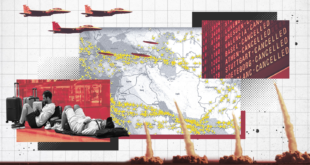The Biden administration thought painstaking diplomacy could contain Iran and, by extension, its proxies in Yemen, Syria, Iraq and Lebanon. But by papering over the Palestinian question, Washington handed its adversary a strategic opportunity.
Short of a nuclear-armed standoff, the stakes arguably couldn’t be higher across the Middle East right now.
The Pentagon — faced with the prospect of getting dragged into a broad regional war that could likely collapse Washington’s entire Middle East strategy — has dispatched veteran commanders of the defeat-ISIS campaign to Tel Aviv in a bid to temper and channel the Israeli resolve.
But as Prime Minister Benjamin Netanyahu made clear on Wednesday, some sort of invasion of the Gaza Strip is certain.
As the ranks of Israel Defense Forces (IDF) reservists rehearse and check their gear, Iran’s Foreign Minister Hossein Amir-Abdollahian issued what appeared to be a final warning before the United Nations in New York on Thursday.
“I say frankly to the American statesmen, who are now managing the genocide in Palestine, that we do not welcome expansion of the war in the region,” Amir-Abdollahian said. “But I warn, if the genocide in Gaza continues, they [the US] will not be spared from this fire.”
There’s good reason to take Tehran at its word, former officials told Security Briefing. For one, Iran’s proxies in Iraq and Syria have already opened a steady stream of small-scale rocket and drone attacks that have lightly injured 21 US personnel, and Iran-backed groups are warning of heavier volleys, including against US bases in Kuwait and the United Arab Emirates.
US military officials say they are taking the threats seriously. On Wednesday, the US Embassy in Kuwait restricted activity of its personnel on military bases in the country.
Yet it is Israel’s northern border that remains a top concern in Washington, and whether Hezbollah will go all-in.
In comments to The Associated Press, a senior Hamas official called for Iran’s proxies to join the fight to relieve pressure on the Palestinian Islamist group. While Hezbollah has given little indication of interest in significantly escalating the conflict, it could potentially be waiting for Israel to commit its forces in Gaza.
“Hezbollah is not going to come in because they think conditions in Gaza are bad,” retired Marine Corps Gen. Kenneth “Frank” McKenzie, former commander of US forces in the Middle East suggested to Security Briefing.
“Hezbollah will come in if they think they have an opportunity to achieve their long-term goal of destruction in Israel,” McKenzie said. “They’re not going to blindly follow Iranian guidance here, because they know they can be hurt very badly by the Israeli response.”
Likely weighing into the calculations: Hamas is a key piece in the triad of Iran’s strategy to surround Israel. Its total destruction could enable the IDF, in any future conflict with Iran’s proxies, to concentrate its forces against Hezbollah in the north.
The Israelis appear to be counting on the overwhelming firepower of the US Navy and Air Force to deter the Lebanese Shite faction from opening a second front. Yet even within the scope of the Gaza operation, there remains a fundamental contradiction between the IDF’s initially stated goal of totally eradicating Hamas and the ostensible task of preserving the lives of the more than 200 hostages held in the Gaza Strip.
That has left Tel Aviv with a dilemma — and the Americans with a chance to buy time.
As Al-Monitor’s Ben Caspit reported, the Israeli high command has quietly moderated its objectives in Gaza and has agreed to delay the invasion at least until additional US Patriot air defense batteries, a THAAD anti-ballistic missile system and the USS Eisenhower reach the Gulf. The USS Eisenhower entered the Mediterranean over the weekend, official ssaid.
Former top US military officials who spoke to Security Briefing surmised that Israel’s beleaguered prime minister, having utterly failed to prevent the worst terror attack in Israel’s history and having now rallied his country for war, must act.
But can Israel achieve its goals without a full-scale ground invasion of the Gaza Strip?
That depends on what Netanyahu would be willing to accept as a victory, former US military officials and two Middle Eastern diplomatic sources told me.
Hamas is threatening to turn Gaza’s dense urban environment, underlain by a massive interlocking web of subterranean tunnels — many likely laid with booby traps — into “hell on earth” for the IDF. Former senior US military officials have compared the fight to the vicious battle for Mosul against ISIS in 2016-17.
“Urban combat is extremely difficult,” US Defense Secretary Lloyd Austin, who has been on the phone with his Israeli counterpart nearly every day since the start of the war, told ABC News on Sunday.
While former military officials say the IDF can likely kill the first- and second-tier leadership of Hamas via lesser means, eliminating the party’s local political leadership — if even possible — would likely require a full-scale occupation, which Israel’s defense chief Yoav Gallant appeared to rule out earlier this week.
Yet the presence of millions of civilians with no escape routes and more than 200 hostages will radically complicate even lesser approaches, military analysts say.
In a sign the Israelis are at least weighing the gravity of the task before them, the IDF overnight on Thursday launched what appeared to be its largest probe yet consisting of an armored column raid into the Gaza Strip.
The IDF said its forces made contact and struck Hamas fighters and infrastructure before returning, having ventured less than a kilometer into the Palestinian enclave.
While the full results of the skirmish remained unclear, IDF spokesperson Lt. Col. Richard Hecht said that there are likely additional shaping operations to come in preparation for next steps.
At least two similar raids have been reported thus far, and likely several more that have not been publicized, former senior military officials told me.
If anything, the incursions suggest the IDF may be heeding the advice of senior American military advisers, among them US Marine Corps Lt. Gen. James Glynn, a veteran commander who helped direct the Raqqa campaign against ISIS in Syria in 2017.
Retired Gen. Joseph Votel, who oversaw all US troops in the Middle East during that war, assessed on Wednesday that the IDF has three potential options to depose Hamas.
A traditional “take-and-hold” clearing operation (in other words, a full-scale invasion likely followed by occupation) would be “extremely time-consuming” in Gaza’s urban environment, given the presence of civilians, Votel said during a virtual think tank event in Washington on Wednesday.
That option is also likely to trigger Iran’s red line, putting some 30,000 US troops and their Arab hosts in the Gulf directly in the crosshairs of Tehran and its proxies’ missile and drone arsenal.
While Western analysts say Iran is not seeking war with the United States, if Arab states come under bombardment, it could feasibly scuttle Washington’s plans to expand the Abraham Accords and tank any hope of US strategic influence in the region for years to come.
Alternatively for the IDF, Votel suggested a more focused “rapid advance to critical objectives” method involving maneuver units seizing key terrain from which to target Hamas operatives and infrastructure in Gaza.
That would offer a lighter-footprint approach, but online images of the IDF seizing neighborhoods could still force the hand of Iran and its proxies, despite the reported threat of US military response.
Thirdly, Votel said, a combination of heavy airstrikes with small, rapid IDF special forces raids into Gaza to gather intel for more targeted raids against Hamas leaders and infrastructure would be the nimblest method.
“We’ve got a lot of experience doing this. This was essentially the tactic we used against al-Qaeda and ISIS,” the former four-star CENTCOM commander and special operations veteran said.
But he cautioned, “There’s a high level of risk with this. You are constantly exposing forces [as] the enemy is watching and adjusting to this.”
It appears those lighter options are already being tested out by the IDF. The outcome of the probing operations will likely determine the shape of the campaign. Either way, it’s likely to be one of the most complex tasks the IDF has ever faced, former US officials said.
On Friday, the US Marine Corps’ top-ranking official, Gen. Eric Smith, confirmed that Lt. Gen. Glynn had returned home.
“Lt. Gen. Glynn went over to provide advice, but make no mistake: what is, has or will unfold in Gaza is purely an Israeli decision,” Smith, the Marine Corps’ four-star commandant, told reporters in Washington on Friday evening. “We are not planning with them,” Smith added.
The fate of Israel’s operation is now entirely in Netanyahu’s hands.
If regional war is to be avoided, the IDF’s ground invasion must be undertaken judiciously. If the trickle of hostage releases continues, it could buy time for Qatar and Egypt to mediate further arrangements, but Israel thus far appears unready for even a temporary cease-fire.
A bloody Israeli occupation of Gaza would likely end Saudi Arabia’s ability to normalize ties with the Jewish state. And full-blown Israeli war with Hezbollah could drive conditions in Lebanon to those of a failed state and draw the US into regional war.
And if Iran’s proxies unleash their volleys in the Gulf and the United States retaliates, any near-term hope of diplomacy to rein in Tehran’s nuclear program would be put in serious jeopardy.
Longtime US allies in the region Jordan and Egypt have been raising the alarm as they face down domestic unrest and economic headwinds amid the war.
“If this erupts, it will be interpreted by people in the Arab world as Muslims versus the West, not as the IRGC and its militia proxies against Israel and the US,” an Arab diplomatic source told me.
Arab leaders have been pressing Washington for years about the need for Washington to follow through on a two-state solution to alleviate Palestinian grievances after decades of dispossession and occupation.
On Wednesday, Biden signaled — belatedly — that his administration was listening.
“When this crisis is over, there has to be a vision of what comes next. And in our view, it has to be a two-state solution,” Biden said alongside Australian Prime Minister Anthony Albanese during a press conference outside the White House.
In a phone call with Netanyahu on Thursday, the American president reportedly echoed those remarks.
“This is a moment of truth for the idea of the West as a model in the Arab world,” the regional diplomatic official told me. “It’s not too late.”
 Eurasia Press & News
Eurasia Press & News



